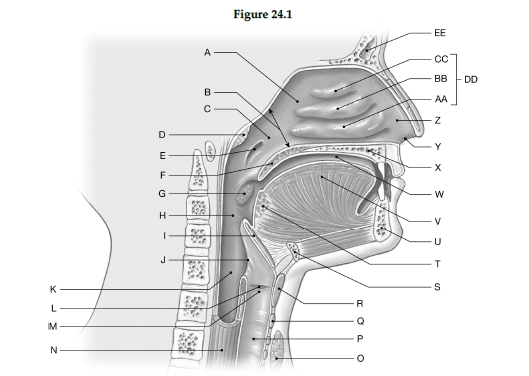Using the figure below, identify the labeled part.

1) Label A: ______________________________
2) Label B: ______________________________
3) Label C: ______________________________
4) Label D: ______________________________
5) Label E: ______________________________
6) Label F: ______________________________
7) Label G: ______________________________
8) Label H: ______________________________
9) Label I: ______________________________
10) Label J: ______________________________
11) Label K: ______________________________
12) Label L: ______________________________
13) Label M: ______________________________
14) Label N: ______________________________
15) Label O: ______________________________
16) Label P: ______________________________
17) Label Q: ______________________________
18) Label R: ______________________________
19) Label S: ______________________________
20) Label T: ______________________________
21) Label U: ______________________________
22) Label V: ______________________________
23) Label W: ______________________________
24) Label X: ______________________________
25) Label Y: ______________________________
26) Label Z: ______________________________
27) Label AA: ______________________________
28) Label BB: ______________________________
29) Label CC: ______________________________
30) Label DD: ______________________________
31) Label EE: ______________________________
1) Nasal cavity
2) Internal nares
3) Nasopharynx
4) Pharyngeal tonsil
5) Entrance to auditory tube
6) Soft palate
7) Palatine tonsil
8) Oropharynx
9) Epiglottis
10) Aryepiglottic fold
11) Laryngopharynx
12) Glottis
13) Vocal fold
14) Esophagus
15) Thyroid gland
16) Trachea
17) Cricoid cartilage
18) Thyroid cartilage
19) Hyoid bone
20) Lingual tonsil
21) Mandible
22) Tongue
23) Oral cavity
24) Hard palate
25) External nares
26) Nasal vestibule
27) Inferior nasal concha
28) Middle nasal concha
29) Superior nasal concha
30) Nasal conchae
31) Frontal sinus
You might also like to view...
What harmful compound does the pancreas release when it does not get enough blood due to circulatory shock?
a. vasopressin b. acetylcholine c. protease d. myocardial toxic factor e. insulin
The lymphocyte is a granulocyte
Indicate whether the statement is true or false
Innervation of a single target by both branches of the ANS
a. is called dual innervation b. occurs only for a small number of organs c. occurs only for sweat gland d. both (a) and (b) e. both (a) and (c)
When electrons are lost from one reactant, they are transferred to another compound in reactions known as:
A) endergonic reactions. B) phosphorylation reactions. C) oxidation-reduction reactions. D) synthesis reactions.